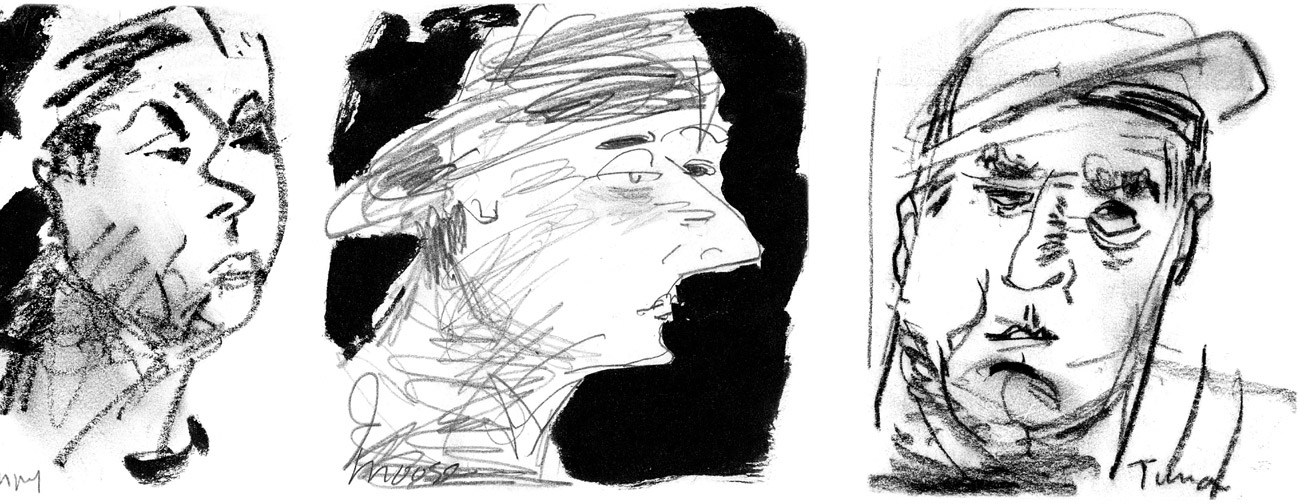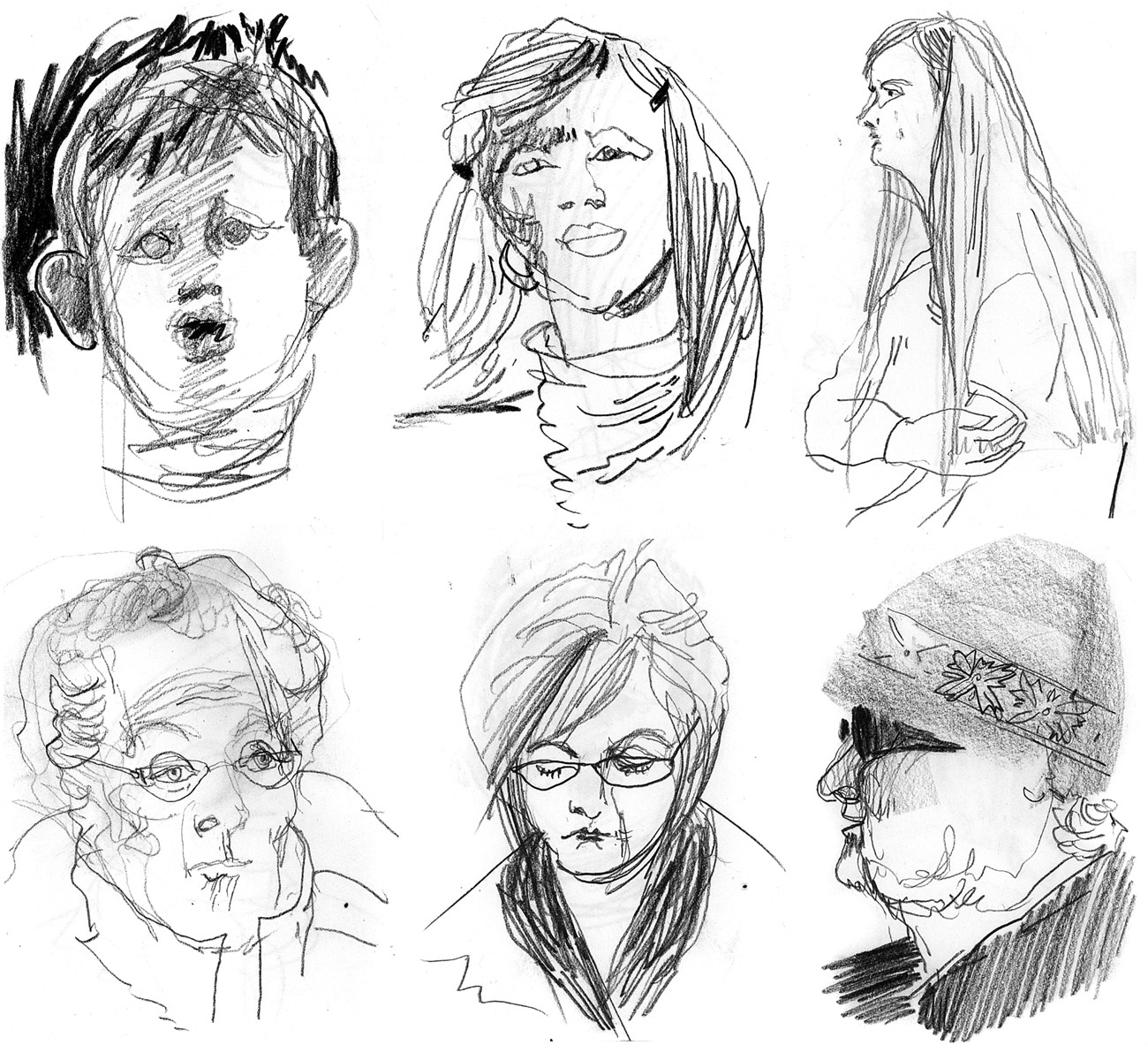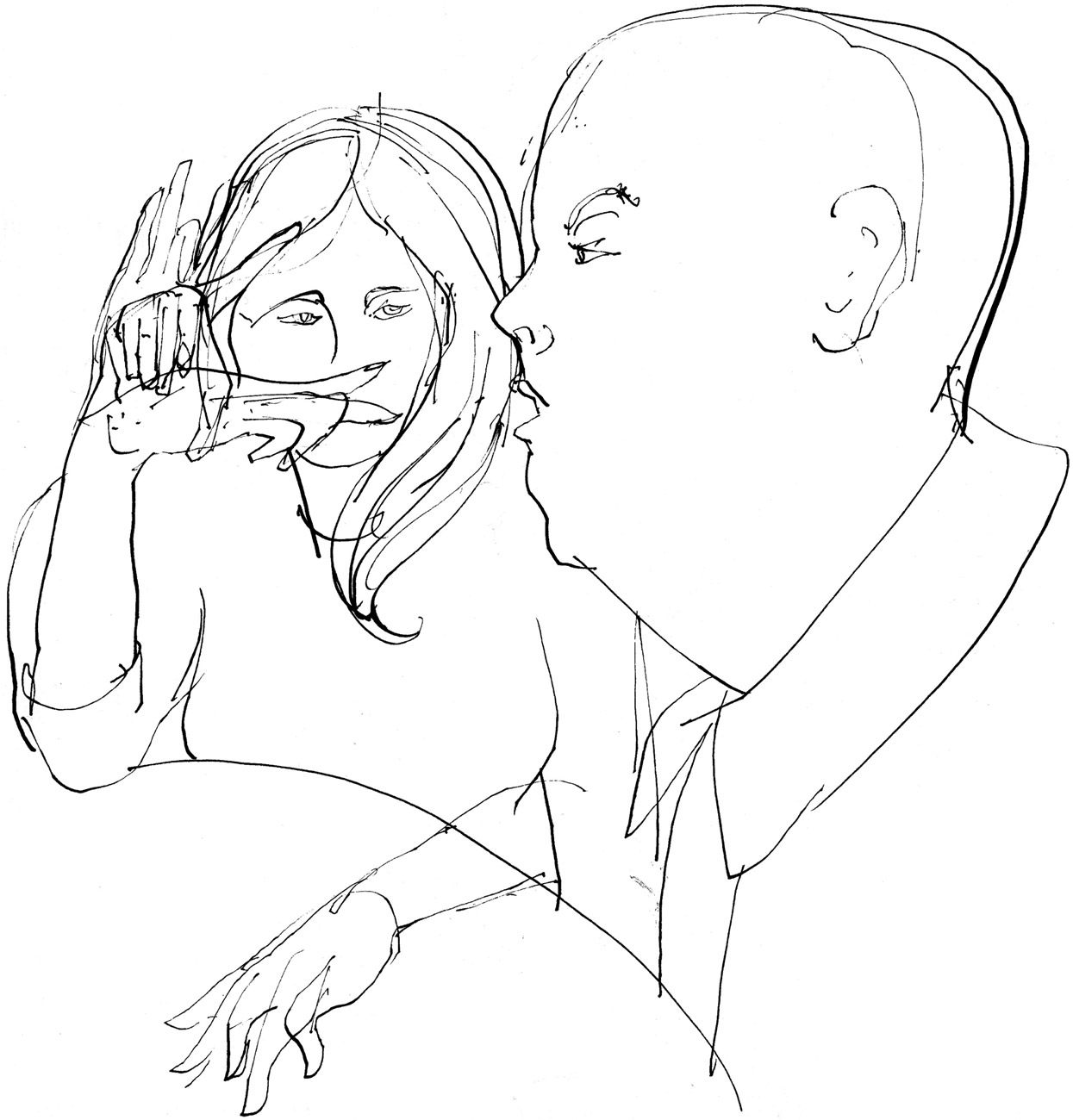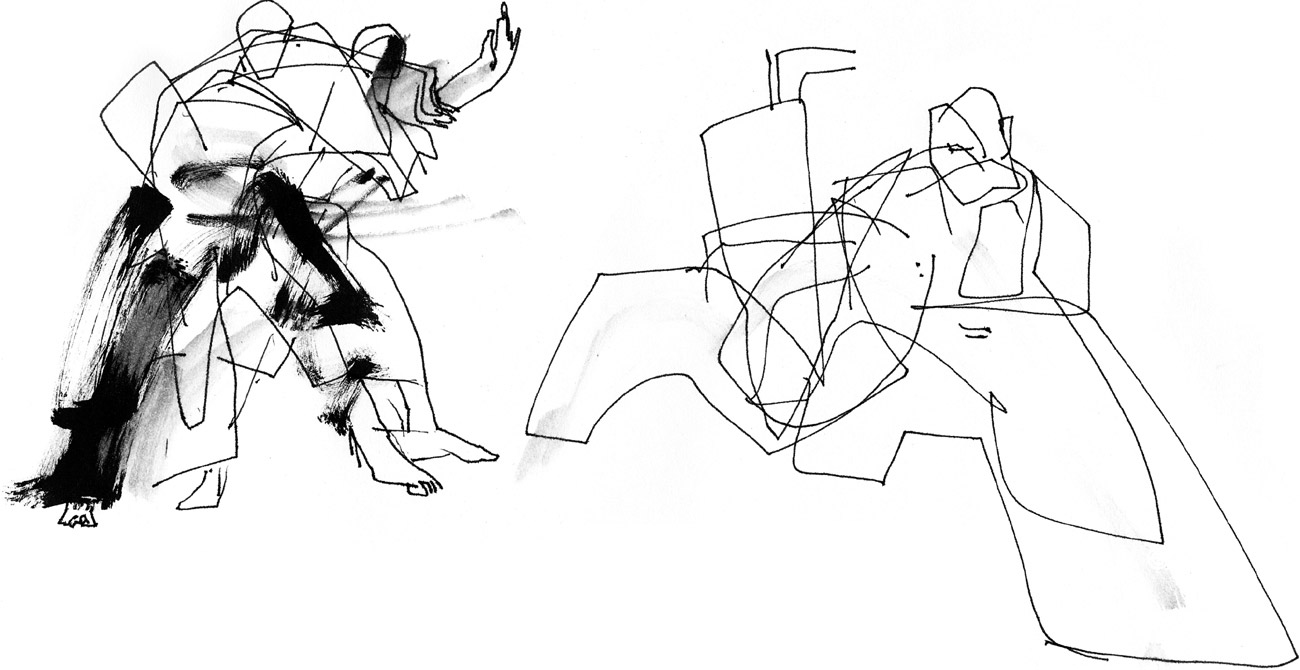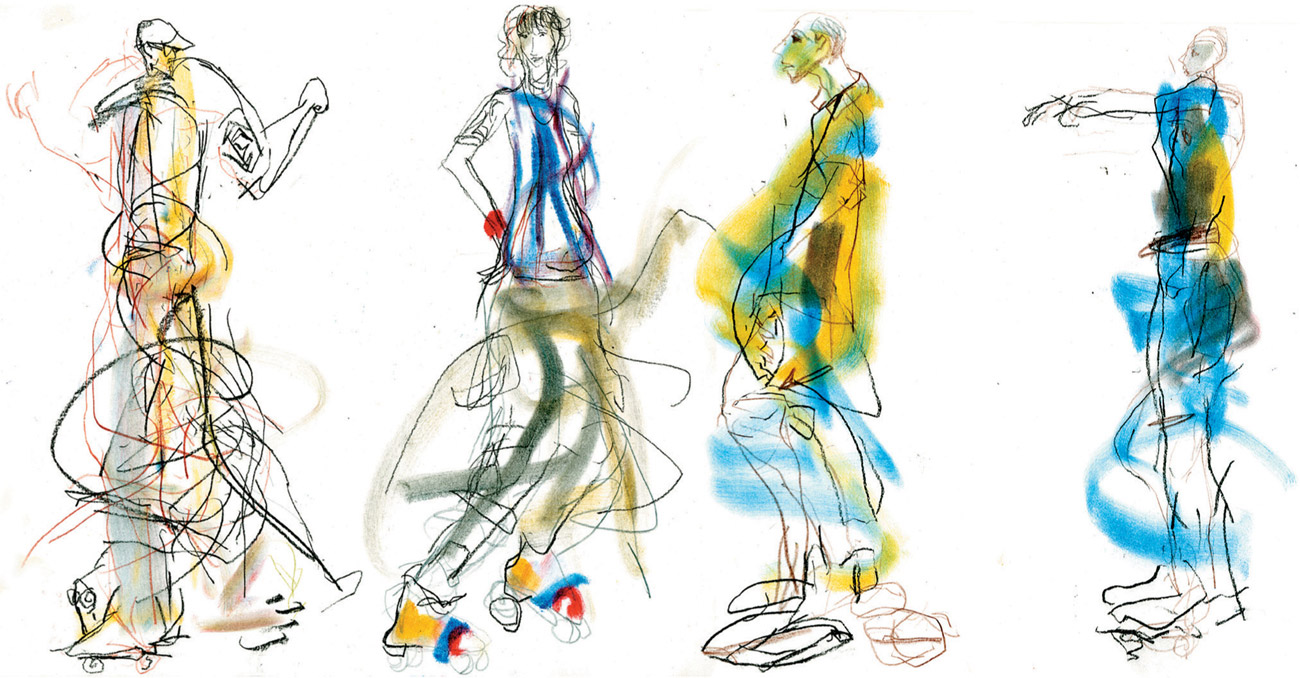Chapter Four:
PEOPLE WATCHING AND CAPTURING MOTION
Faces of construction workers, by Margaret Hurst, graphite and charcoal pencil
DAY 17
Café portraits, pencil on paper
“I spent the afternoon at a Barnes and Noble bookstore the other day. During my break for coffee at the Starbucks café, I made some drawings of the people around me. Clockwise from top left: the whiny kid; the satisfied customer; the shy girl waiting to order; the eccentric dude; the quiet reader; the old woman in a wheelchair.”—Despina
EXERCISE 17
Go to a local café and find a good seat. Order yourself a coffee, or latte, or whatever you like to drink, and open your sketchbook. Using a range of pencils, draw portraits of the other patrons at the café. Think about how to show their personalities as well as get their likenesses down. Despina draws body language and uses graphic markings to describe the feeling that each person gives her. The whiny kid has a lot of agitated marks on his face; the satisfied woman has a smug expression; the shy girl is hugging herself; the eccentric dude is hidden by his glasses and the shape of his hat; the quiet reader is looking down, and the marks of the drawing amplify that direction; the old woman in a wheelchair has curly lines all over.
Observe people’s expression and body language and play with different kinds of marks in a similar way to show personality. Have fun, and if someone catches you drawing them, smile and show off your work of art!
VARIATION
Instead of drawing anonymous people at a café, you might try making a drawing of a “local legend:” someone who is famous in your town. For example, in this drawing (below) Greg has drawn a man known as “the Gentleman Peeler.” He was well known in New York City’s Union Square Park as a salesman of vegetable peelers who took his work very seriously! A drawing like this can become part of the oral and social history of a town.
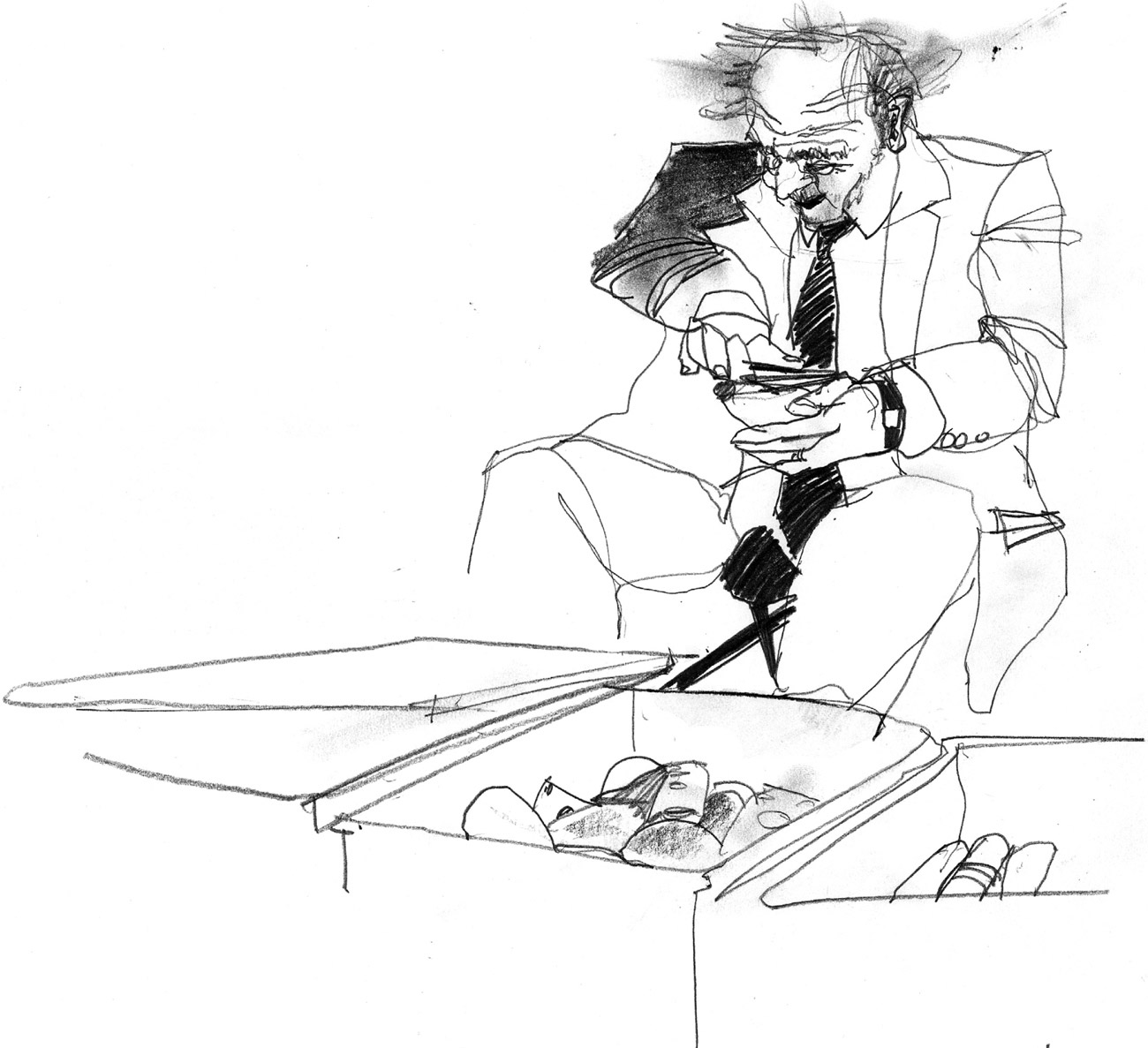
The Gentleman Peeler, pencil drawing on paper
DAY 18
“These two people were so much fun to draw. She was talking with her mouth and her hands. He was trying to say something but couldn’t get a word in edgewise. She was talking with one hand going in the air and the other hand running back and forth across the tabletop. It was like sign language with simultaneous interpretation!
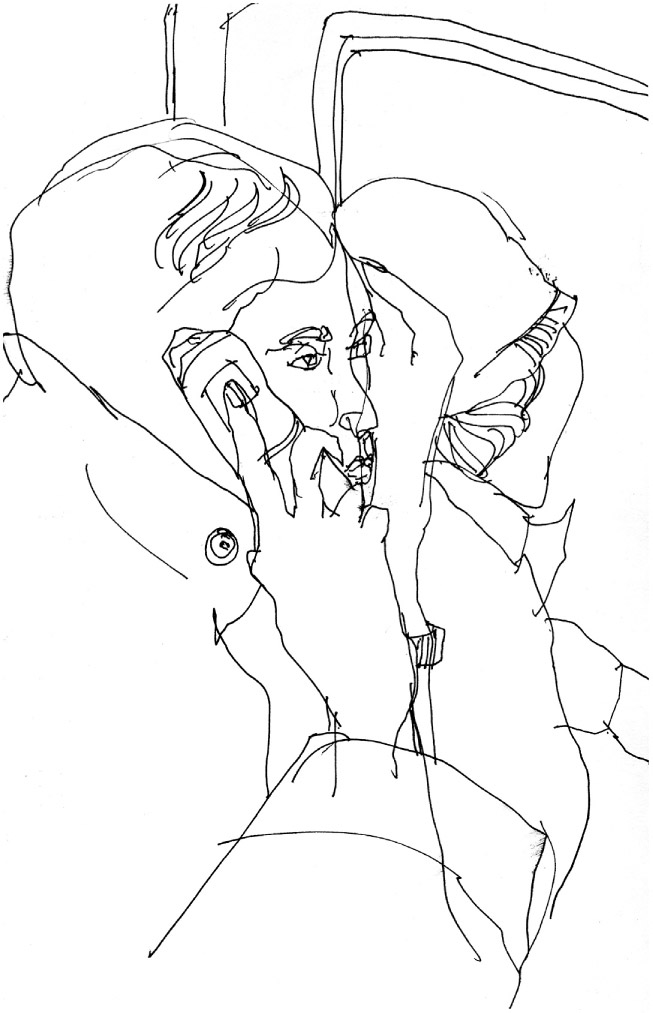
Commuter on cell phone, pen line
“This was the moment when he finally dared to open his mouth. It didn’t stay open too long! You can see the frustration in his arched eyebrow. Trés cool!”—Margaret
EXERCISE 18
Go to a café or place where people gather and draw a couple of people having a conversation. Pay close attention to their expressions and their body language. See if you can’t figure out what the conversation is about through your observation.
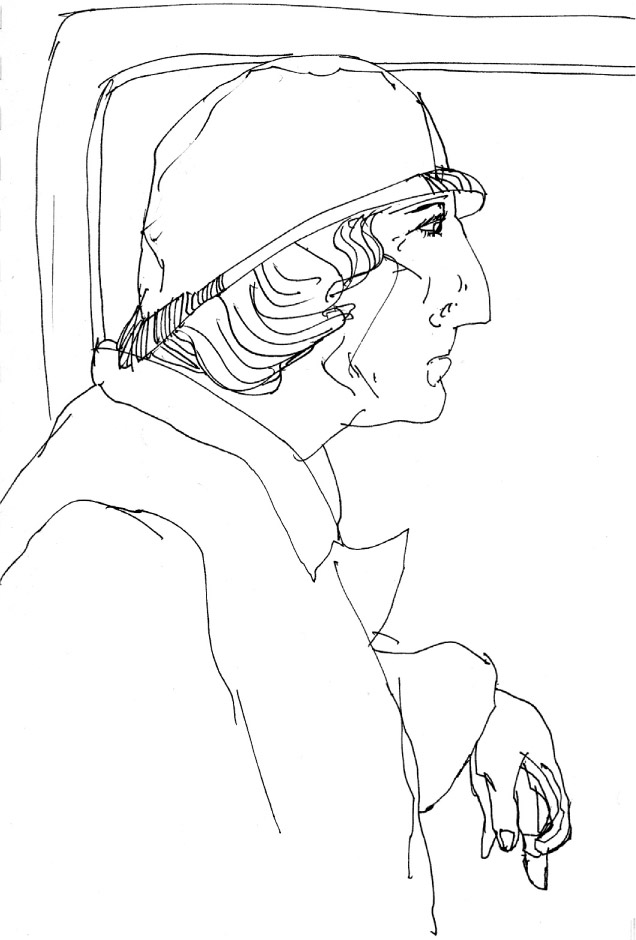
Annoyed commuter, pen line
Don’t be afraid to draw things multiple times as Margaret has done with the lady’s hand at right. This creates a sense of motion in the drawing.
VARIATION
Action/reaction: Find a place with a lot of people, such as a train or a bus, as Margaret has done in the two drawings at left. Look to see if someone is doing something, such as speaking on a cell phone or eating loudly, which is creating a reaction in another person. It could be something nice as well, such as a musician performing in a public space and an enthusiastic admirer. Really observe facial expression and body language and mark them down in your drawing.
Couple in conversation, pen and ink
DAY 19
“This is a drawing of some ladies listening to traditional Irish love songs. Their love for the music was obvious. As a music lover myself, I was touched by that, though I could not help but indulge a little in drawing their odd shapes!”—Kati
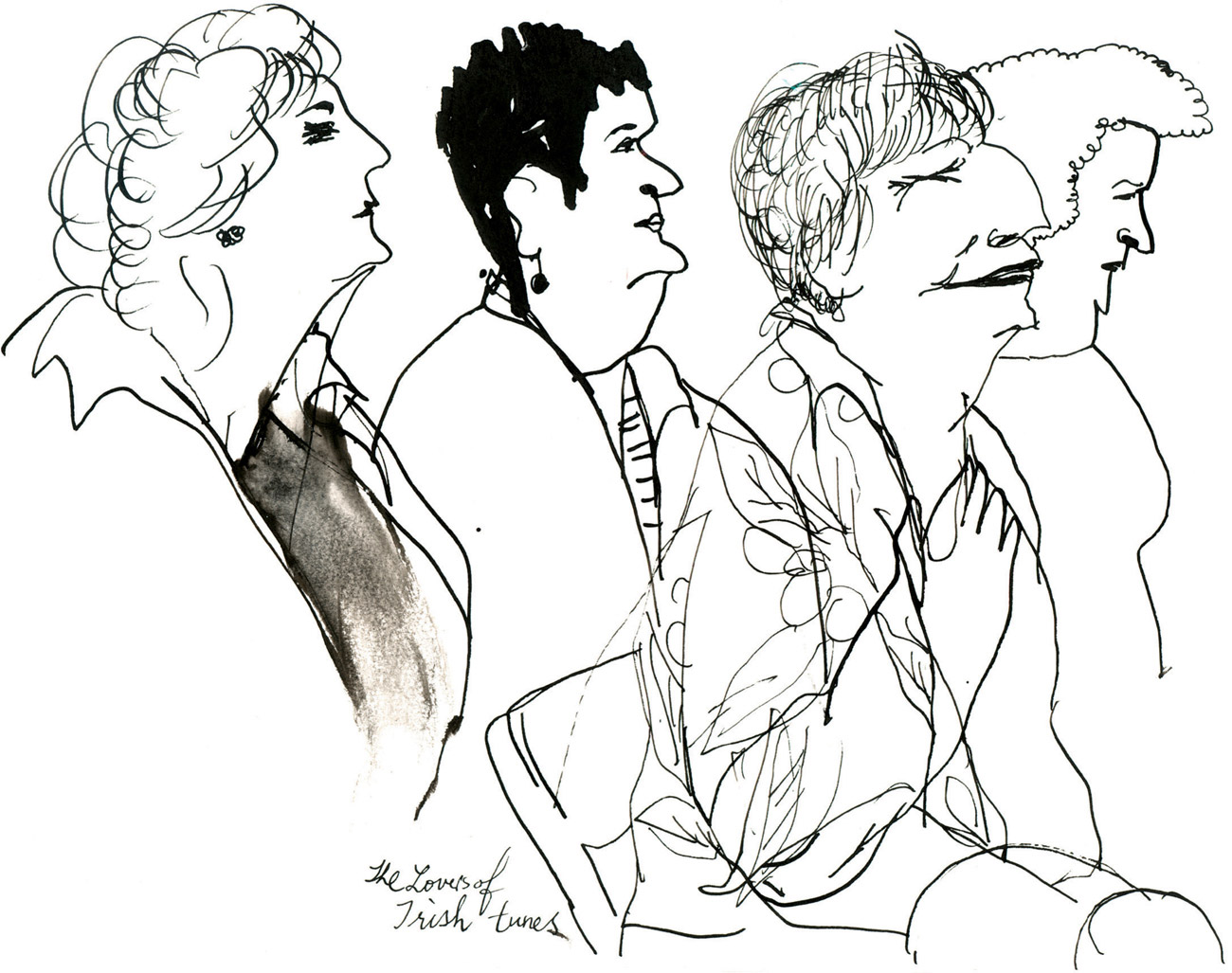
Music lovers, pen and brush with ink
Today’s exercise is all about the profile! Go to a place where there will be a lot of people facing in the same direction for an extended period of time, such as a music concert, a line for a show, or some kind of convention. You might even do this while riding on a train or airplane.
Using a portable fountain pen, pencil, charcoal pencil, or brush pen, or a mix of all of them, create a series of simple profile portraits of the people you see. Notice the differences between the various people and don’t underestimate the importance of body language.
Some people keep their chin down, others have their nose in the air, while others keep themselves looking straight ahead at all times! Combined with the position of the shoulders and back, the profile body language can reveal quite a lot about a person’s emotional state of mind.
TIPS
- Don’t be afraid to exaggerate the features of the profile you are drawing, as Kati has done in the drawings at left and below.
- You might even seek out people with large noses and unusually shaped faces; they are often the most fun to draw!
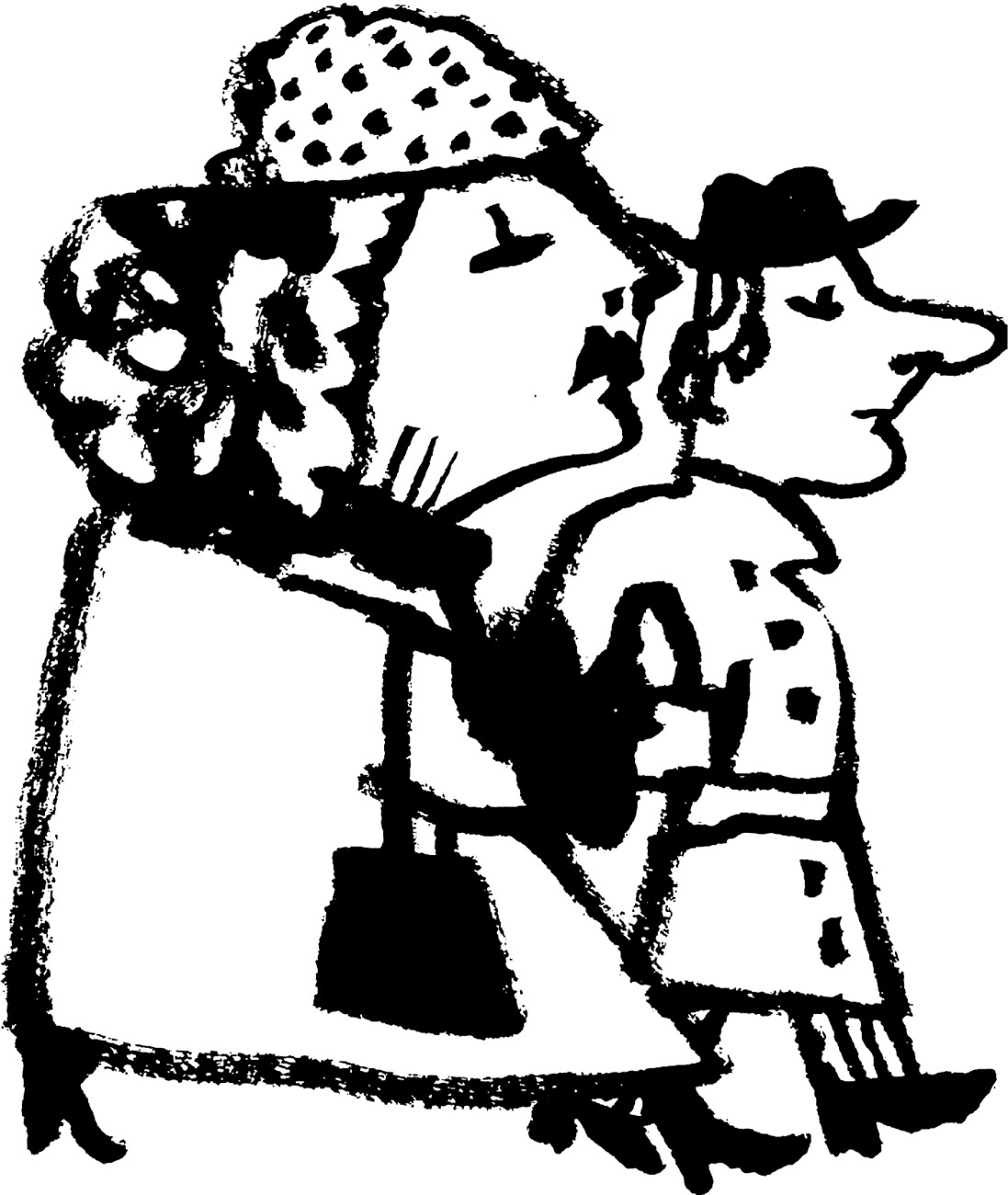
New Yorkers, brush and ink
DAY 20
“This is a drawing I made of the spectators at the annual Greenwich Village Halloween parade in New York City. You can see that some of the people are watching the parade, some are watching the watchers, and some seem to be having a cocktail on a New York City bench. It’s really a very relaxed, easy scene: what used to be called ‘groovy.’ I enjoy going to draw these kinds of public events not only for the main issue, such as the parade, but for all the practice I get from drawing the onlooking crowd!”—Veronica
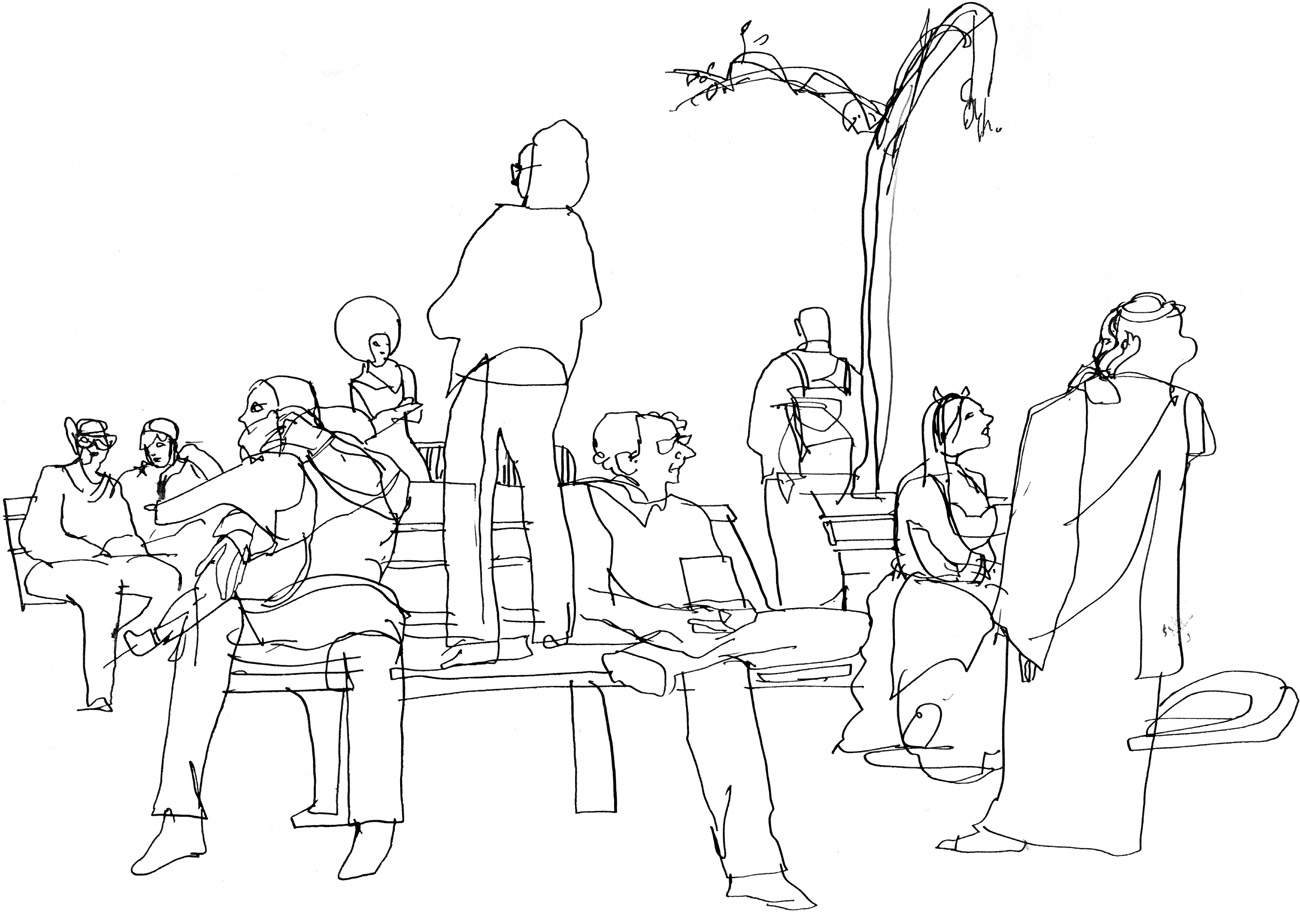
Parade spectators, pen and ink
Go to a place where there is sure to be a crowd of people. If there is a parade in town, terrific; if not, you can go to your local shopping mall. Select a spot where people gather, such as a bench or waiting in line, and make a drawing with a fountain pen. You can use a dip pen and bottle of ink, if you prefer, for a bit more flair to the line.
If you’d like, use water-soluble crayons to create a color drawing, such as the one Greg has done at right. The main thing is to look for the body language of the people and at how the crowd has a shape of its own. Don’t find yourself drawing each person separately: Notice how one shape of a person connects to the other. Create a scene consisting of mainly people; at least five would be good to start. Add a little bit of background for context. You could mix the line and color too, if you prefer.
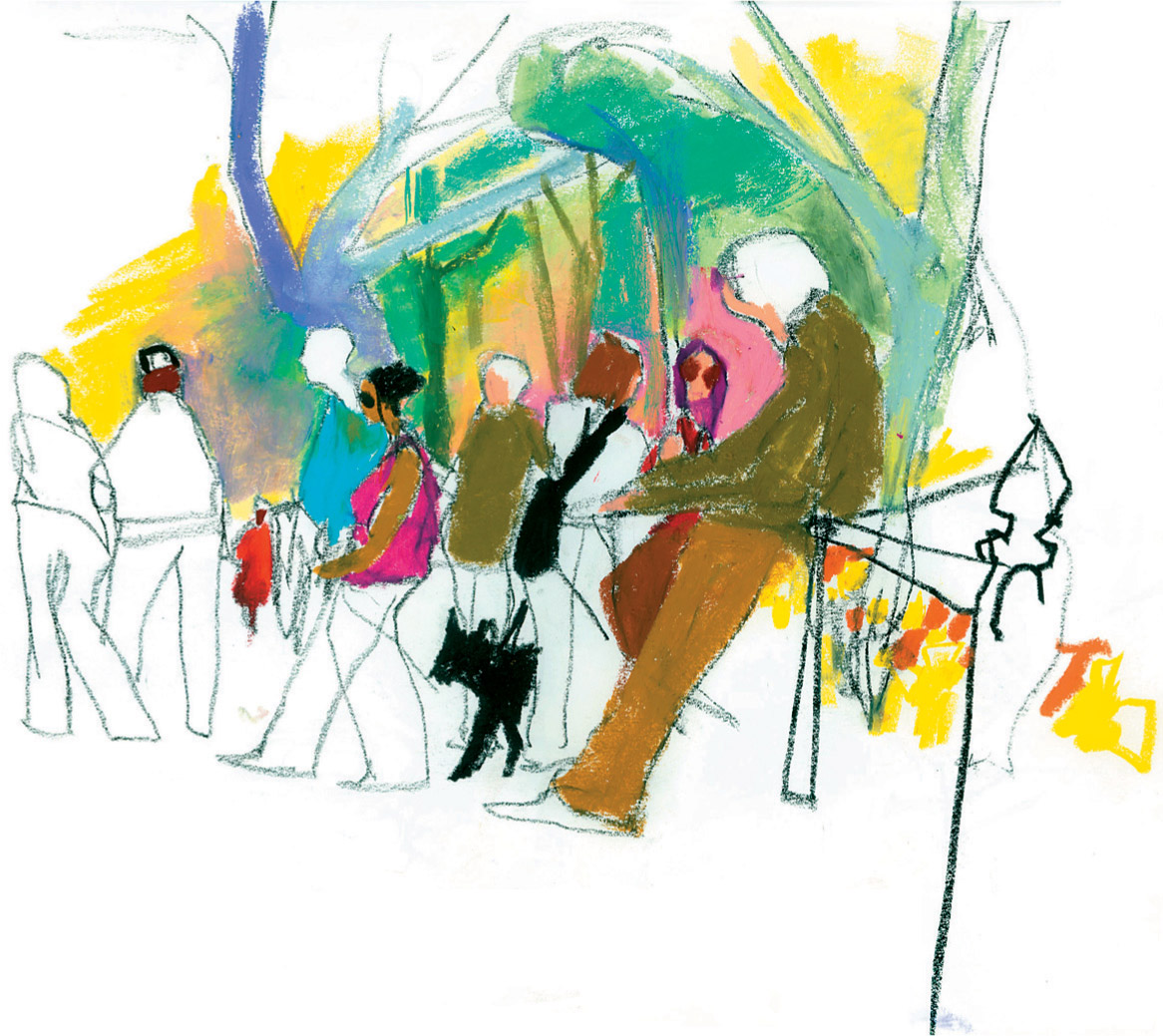
People, Washington Square Park, water-soluble crayon
TIP
- It’s a good idea to carry a small sketchbook and fountain pen in your pocket or purse so as not to miss opportunities to practice your drawings of people. Michele made this lovely drawing of movie patrons looking for seats, below, while waiting with her husband for the feature to begin.
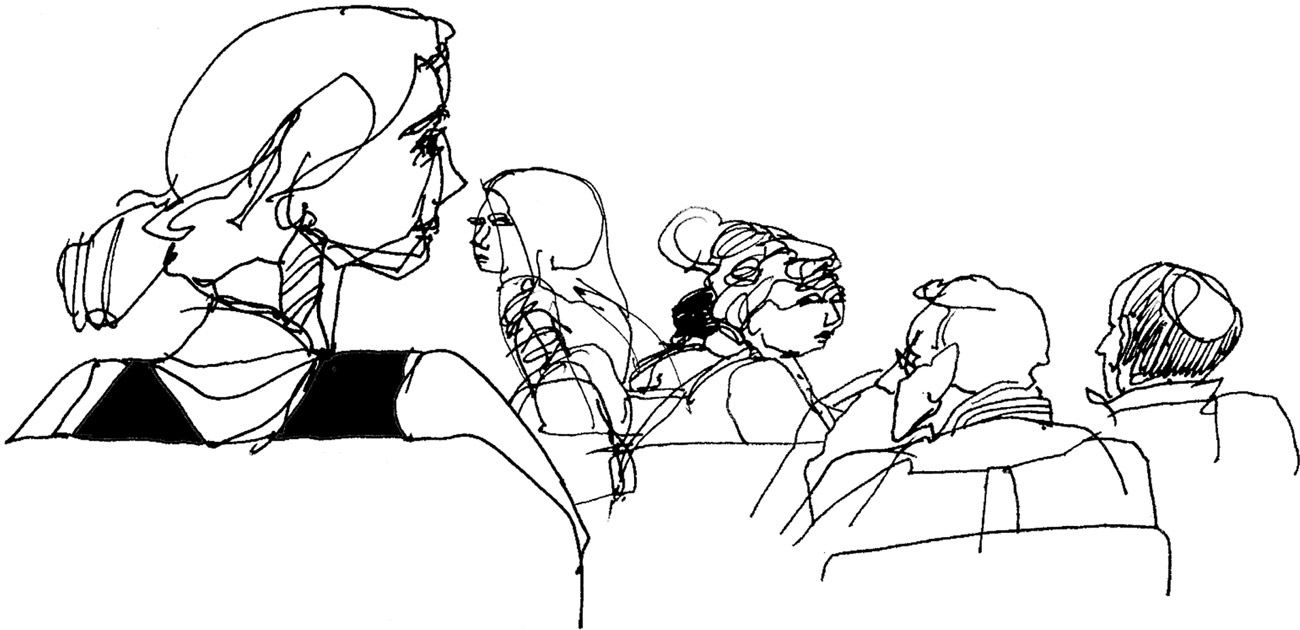
Movie crowd, pen and ink
DAY 21
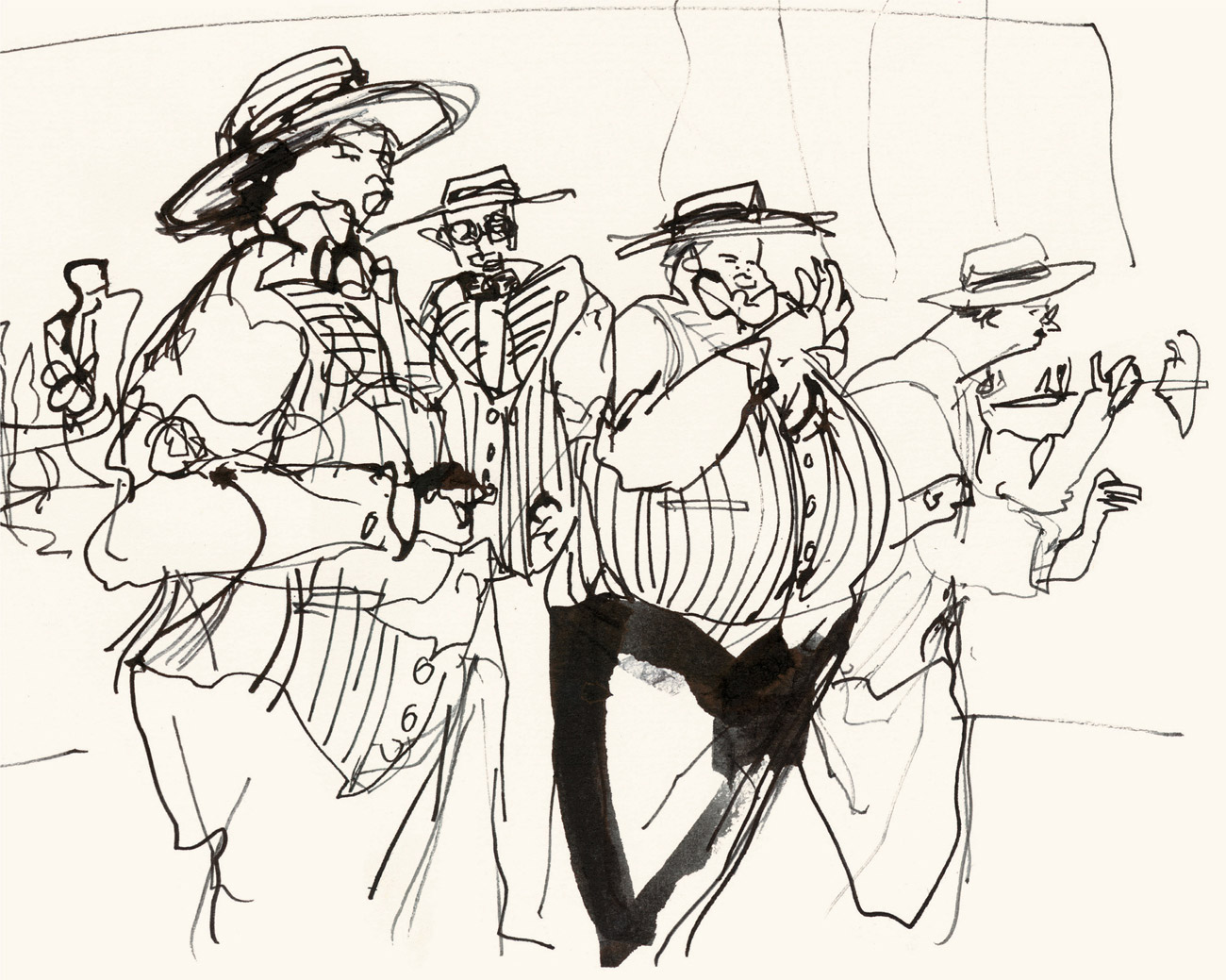
Barbershop quartet, pen and brush and ink
“I figured it was a good day for a song. Something traditional. A classic: easily sung along with. This drawing that I made of the barbershop quartet at Disney World reminds me of a perfect Saturday afternoon spent listening to some good old classic melodies and hanging out with friends.”—Dominick
EXERCISE 21
How do you capture music, and musicians, on paper? Only one way to find out—by drawing them! For this exercise, visit a local church choir, your son’s garage band, a local orchestra in rehearsal or performance: You get the idea. While there, make a drawing or two of the musicians doing what they love, performing. Try to work with a type of music that resonates with you. Dominick enjoys the old-fashioned American sound of the barbershop quartet and chose to draw them with a dip pen and brown ink on cream-colored paper, to get both the expression of the musical feeling and the light sepia tone we often associate with “the good old days.”
Think about what mediums best represent the graphic expression of the feeling the music gives you. It’s a good idea to bring an assortment of materials with you on location to do this exercise, as you may not be aware of what type of medium feels like the music until you hear it!
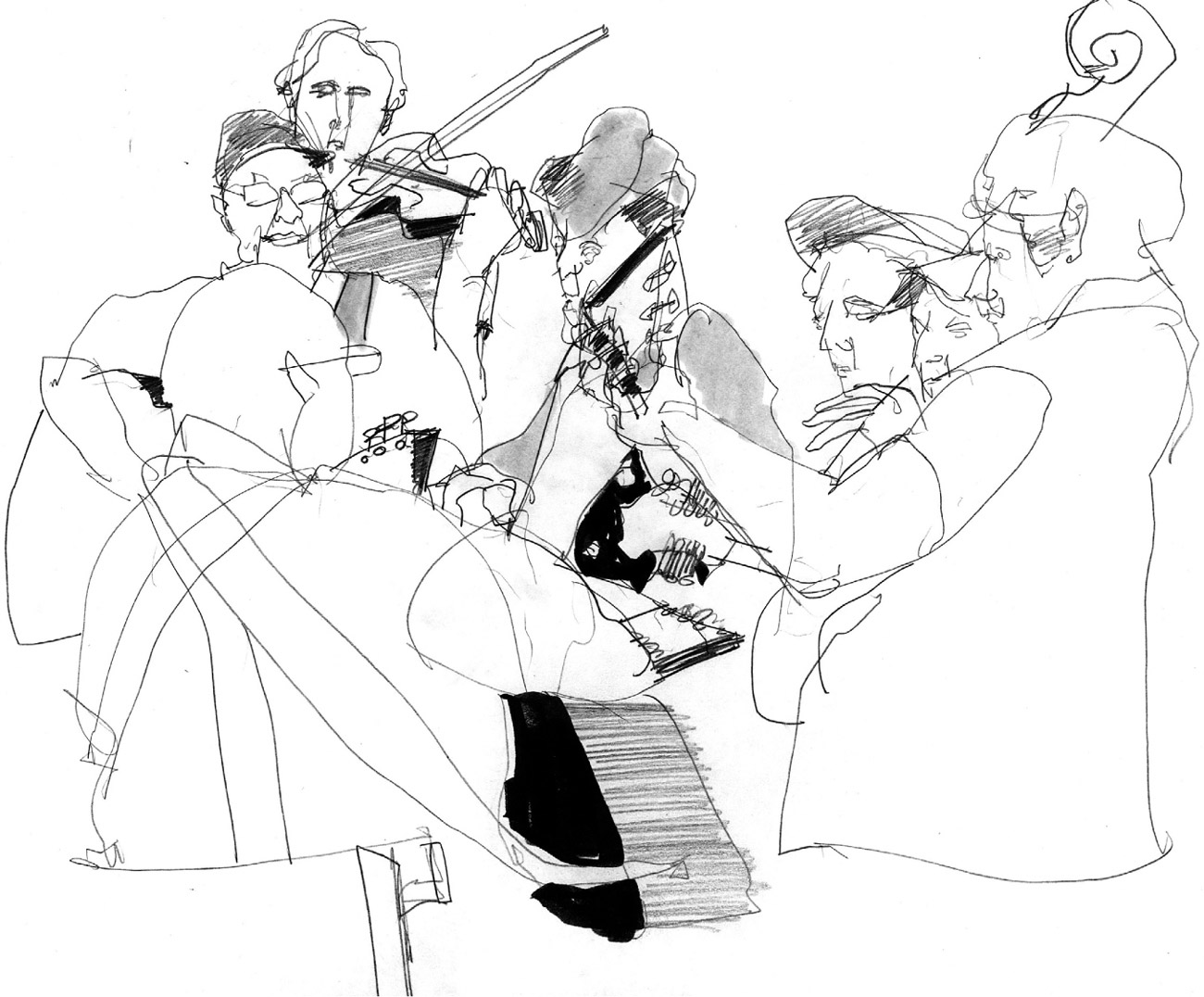
Café musicians, pencil and marker
VARIATION
You might try picking two separate musical genres to see how you interpret each graphically. What are the differences between the sounds of the two musical types, and how do those differences affect the type of materials you choose to draw with, and the speed of your drawing? Drawing has pacing inherent in it: If you draw faster, you’ll get a different feel than if you draw more slowly. Dominick’s drawing at left has a quick, upbeat feel to it that reflects the music he is hearing while working; Greg’s drawing of a gypsy jazz café group has a slower, more deliberate pace that reflects the sinuous sounds of the café scene.
DAY 22
Aikido practice, pen and brush
“I had another fun evening recently drawing my husband, Neil, and his fellow aikido practitioners at the Long Island Aikikai dojo. It’s fun to try to capture their moves on paper and, I think, a much less strenuous way for me to participate!”—Veronica
EXERCISE 22
Go to your local gym or YMCA and ask to draw during one of their classes. Any sport that involves two opponents will work for this exercise: aikido, karate, wrestling, boxing; even a sport such as tennis would be perfect. Using portable materials such as a razor-point disposable pen and brush marker, draw the opponents while they are engaged in their sport. Keep your eyes on them while you draw and try to follow their movements with your pen. You might use the brush pen for bolder lines or shapes that can help identify what’s going on. Don’t worry about likenesses or tight details: Simply go for the overall movement and feel of the athletes. Take advantage of repetitive movements to work on parts of your drawing more than once. And keep far enough away from the action so you don’t get kicked!
VARIATION
Try making the drawings with color for an additional challenge. A portable combination of mediums such as the colored pencil and pastels that I use here keeps your drawing quick—and no spills! Think about the shapes between the athletes as something that can be drawn as well as the athletes themselves. You might use a softer medium such as pastel for movement and a harder medium such as colored pencil for details that you want to incorporate. Or you might use many lines for movement and the soft material to block in shapes. Experiment to see what works for you.
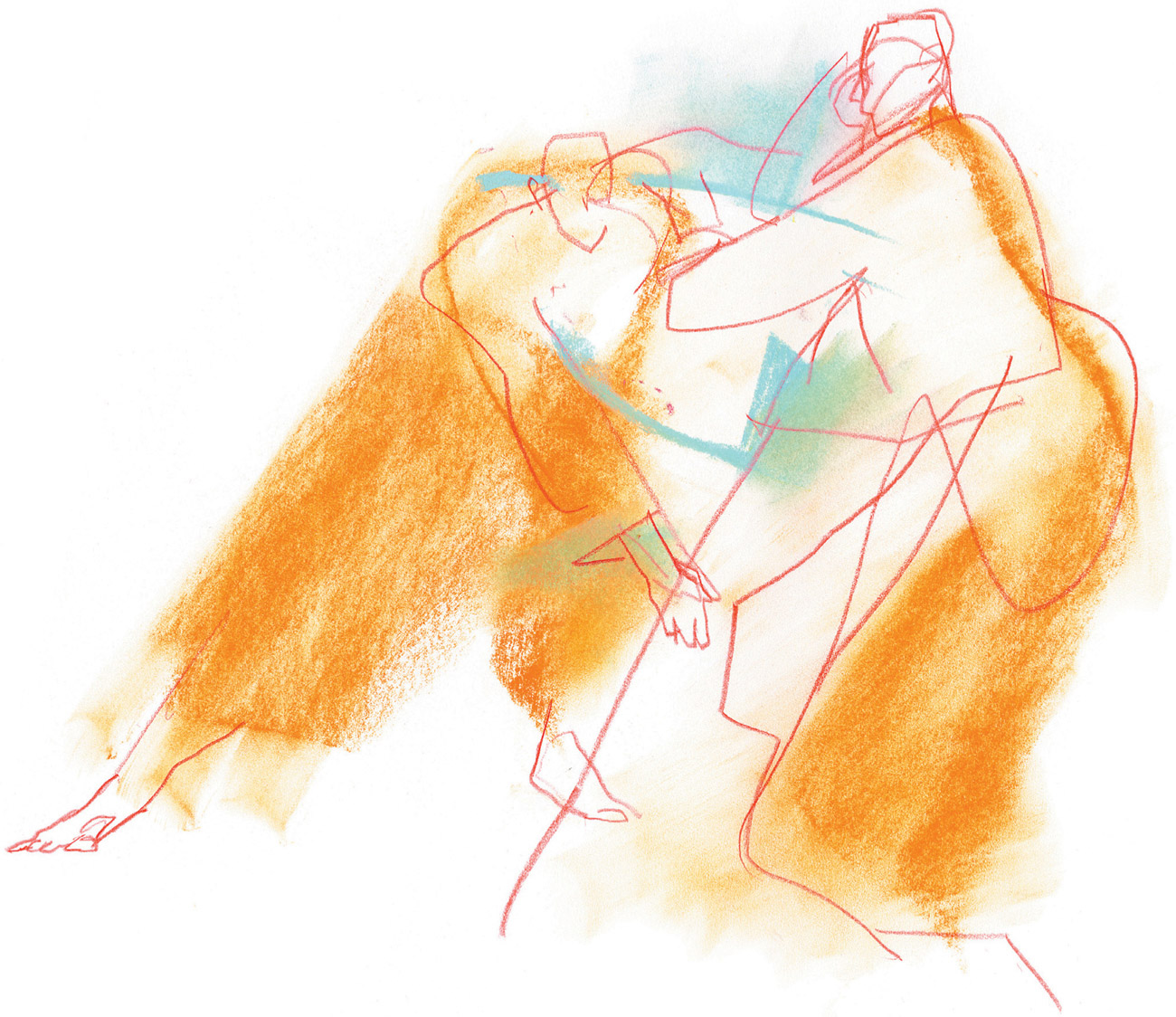
Aikido opponents, pastel and colored pencil
DAY 23
Roller skaters in motion, ink and PanPastel
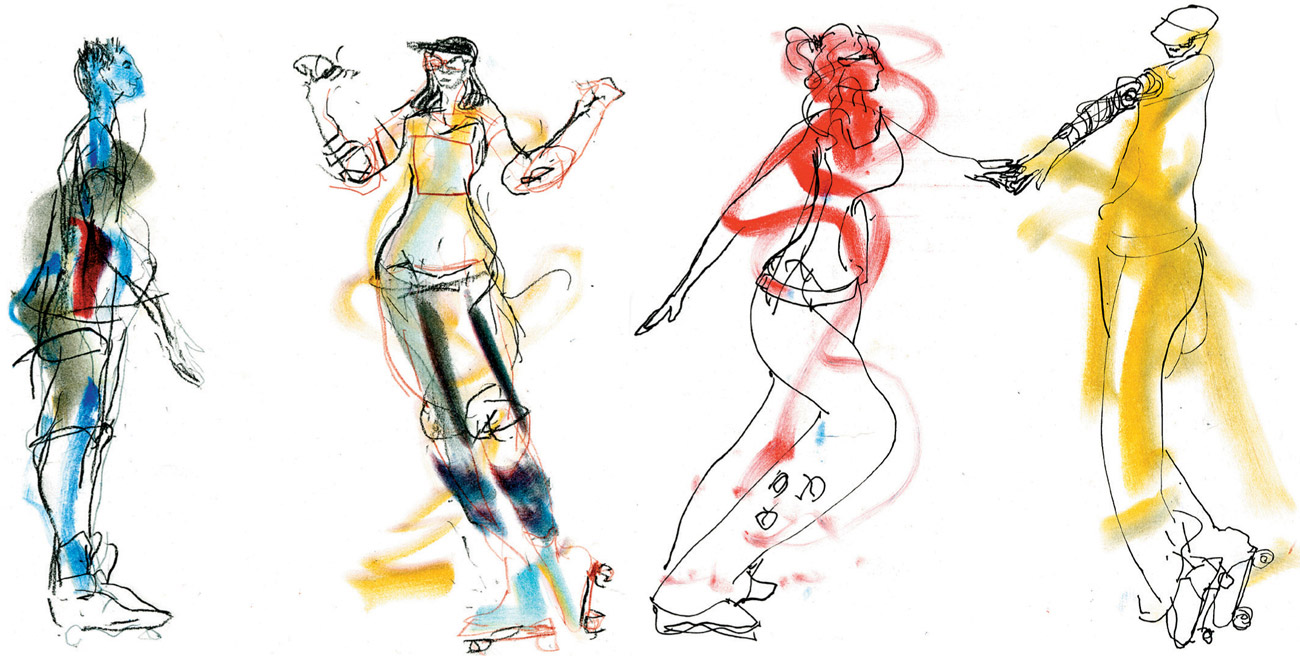
“I have been making drawings of the Central Park Dance Skaters Association skaters, in Central Park, for about two years now. I love following their movements, and it’s exciting when they go wild, which happens a lot! They can’t seem to help themselves; they just have to go a little nuts now and then. I’m more than happy to be there, watching and drawing them when it happens!
“This time, I decided to draw the skaters with two hands simultaneously. It felt more comfortable to me than drawing them with one hand: I could accomplish more with a two-handed drawing than with a one-handed drawing! You can capture the essence of the body movement quicker and more succinctly. I also used my PanPastel colors—what a delightful way to spend the afternoon.”—Margaret
EXERCISE 23
Draw with two hands at the same time. Find a group of active people: dancers, skaters, bikers, or joggers. Lay your paper down on the ground and situate yourself so you’re over it. Look at the people and, without looking down at your paper, draw with two hands at the same time. Keep both hands moving and keep them drawing in separate areas of the paper. Trust your instincts and you just may be surprised at what happens!
TIP
- Try putting a different medium in each hand for more expressiveness. Having color in one hand and black line in another will help you to capture not only the movement, but also the detail and visual information you need to communicate.

Spinning skater, charcoal pencil

